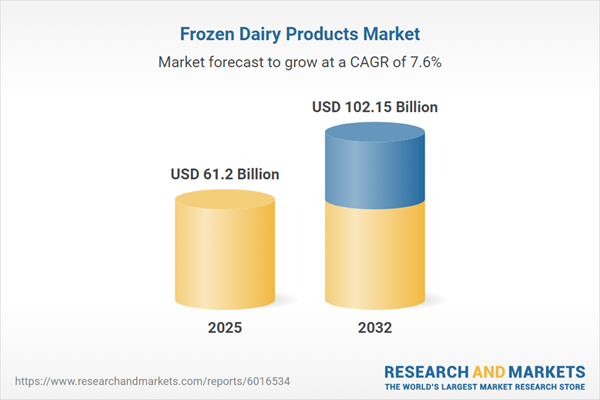Speak directly to the analyst to clarify any post sales queries you may have.
The frozen dairy products market is experiencing rapid transformation, driven by changing consumer demands, technological advances, and strategic moves by both established leaders and niche innovators. For senior decision-makers navigating this landscape, understanding core drivers, risks, and opportunities is essential for strategic planning and competitive advantage.
Frozen Dairy Products Market Snapshot
The frozen dairy products market grew from USD 56.83 billion in 2024 to USD 61.20 billion in 2025. It is projected to maintain robust momentum, with a compound annual growth rate (CAGR) of 7.60%, reaching USD 102.15 billion by 2032.
This expansion is fueled by evolving consumer expectations for premium quality, unique flavors, and sustainability, as well as significant investments in supply chain resilience and digital engagement. The primary keyword, "frozen dairy products market," reflects the breadth of innovation and competition shaping the industry’s growth trajectory.Scope & Segmentation
This report provides in-depth coverage and segmented analysis to guide actionable decisions:
- Product Types: Ice cream, Gelato, Frozen yogurt, Frozen novelties, Frozen custard, Sorbet
- Distribution Channels: Supermarkets and hypermarkets, Specialty stores, Convenience stores, Online retail
- Packaging Types: Bulk formats for commercial users, Multi-packs, Sandwiches, Stick bars, Tubs and cups for on-the-go or individual consumption
- Flavors: Chocolate, Strawberry, Vanilla, with emerging varieties such as salted caramel and fruit blends
- End Users: Commercial sectors including restaurants and hotels, and household consumers with varied buying patterns
- Regional Coverage: Americas (United States, Canada, Latin America), Europe, Middle East and Africa (including Western and Eastern markets, Gulf states, and key African economies), Asia-Pacific (China, India, Japan, Southeast Asia, Australia, and others)
- Featured Companies: Unilever PLC, Froneri International Limited, Nestlé S.A., General Mills, Danone S.A., China Mengniu Dairy Company, Inner Mongolia Yili Industrial Group, Meiji Holdings, Lactalis Group, Mars, Incorporated
Key Takeaways for Senior Decision-Makers
- Demand is transitioning from traditional products to offerings that balance indulgence with health and clean-label transparency, presenting clear opportunities to diversify portfolios.
- Digital platforms and direct-to-consumer models are reshaping market access and consumer loyalty, requiring companies to adapt omnichannel strategies for enhanced engagement.
- Investment in supply chain and cold chain technologies ensures efficiency and product quality, supporting market penetration across geographies with complex logistics needs.
- Emerging markets—particularly in Asia-Pacific, Latin America, and select Middle Eastern regions—are driving consumption growth due to demographic expansion and rising incomes.
- Innovation around sustainable packaging, renewable energy in production, and reduced food waste is increasingly a competitive differentiator, meeting both regulatory and consumer demands.
Impact of United States Tariffs in 2025
The recently implemented U.S. tariffs on frozen dairy products and ingredients have caused manufacturers to reassess sourcing and production strategies. Many are shifting toward regional supply chains or partnering locally to manage cost volatility. This adjustment has also prompted retail and distribution players to renegotiate contracts and explore consolidated procurement, driving efficiencies and potential consolidation throughout the value chain.
Methodology & Data Sources
This analysis is underpinned by a comprehensive, multimethod research framework. The methodology combines structured interviews with industry leaders, in-depth field surveys, and secondary reviews of industry publications and public filings. Rigorous quality controls—such as cross-verification, regression modeling, and peer consultant review—ensure both accuracy and actionable insights.
Why This Report Matters
- Enables executives to align innovation, sustainability, and market entry strategies with verified consumer and regulatory trends.
- Supports informed risk management and opportunity identification in light of evolving tariffs and global supply chain complexities.
- Delivers reliable, segment-specific intelligence to inform investment decisions and strategic planning in the frozen dairy products sector.
Conclusion
The frozen dairy products market offers significant growth potential for well-positioned organizations that act on data-driven insights and sector-specific trends. Strategic investments in innovation, resilience, and sustainability will be instrumental in capturing future market share and maintaining long-term relevance.
Additional Product Information:
- Purchase of this report includes 1 year online access with quarterly updates.
- This report can be updated on request. Please contact our Customer Experience team using the Ask a Question widget on our website.
Table of Contents
3. Executive Summary
4. Market Overview
7. Cumulative Impact of Artificial Intelligence 2025
Companies Mentioned
The companies profiled in this Frozen Dairy Products market report include:- Unilever PLC
- Froneri International Limited
- Nestlé S.A.
- General Mills, Inc.
- Danone S.A.
- China Mengniu Dairy Company Limited
- Inner Mongolia Yili Industrial Group Co., Ltd.
- Meiji Holdings Co., Ltd.
- Lactalis Group
- Mars, Incorporated
Table Information
| Report Attribute | Details |
|---|---|
| No. of Pages | 186 |
| Published | October 2025 |
| Forecast Period | 2025 - 2032 |
| Estimated Market Value ( USD | $ 61.2 Billion |
| Forecasted Market Value ( USD | $ 102.15 Billion |
| Compound Annual Growth Rate | 7.6% |
| Regions Covered | Global |
| No. of Companies Mentioned | 11 |









